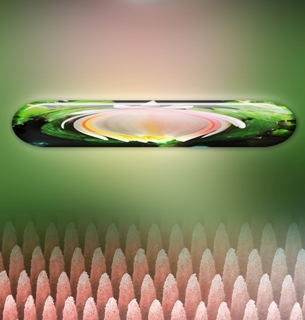Aug 6 2015
A collaborative team of researchers from City University of Hong Kong, Dalian University of Technology in China and Ariel University in Israel, has discovered that the impact of a droplet on a solid surface is more complex than just the spreading and retracting phases. The team has reported their study in the Applied Physics Letters journal, from AIP Publishing.
 Droplet hitting tapered posts shows “pancake” bouncing characterized by lifting off the surface of the end of spreading without retraction. Credit- Z.Wang/HKU
Droplet hitting tapered posts shows “pancake” bouncing characterized by lifting off the surface of the end of spreading without retraction. Credit- Z.Wang/HKU
“During the spreading phase, the droplet undergoes an inertia-dominant acceleration and spreads into a ‘pancake’ shape,” explained Zuankai Wang, an associate professor within the Department of Mechanical and Biomedical Engineering at the City University of Hong Kong. “And during the retraction phase, the drop minimizes its surface energy and pulls back inward.”
In repellant or superhydrophobic surfaces minimal energy dissipation takes place during impact, and hence the droplets jump off when the retraction stage ends. The surfaces of lotus leaves are considered to be gold standard superhydrophobic. An air cushion is present within the rough surface and this is considered to be the cause of the droplets jumping off.
A classical limit exists in terms of the contact time between gold standard superhydrophobic materials and the droplets. Earlier, the research team had reported in the Nature Physics journal that a droplet could be suitably shaped so that it bounces in a in a pancake shape from the surface directly when the spreading stage ends, without the necessity of following through the receding process. Hence, the droplet sheds away at a faster rate.
“Interestingly, the contact time is constant under a wide range of impact velocities,” said Wang. “In other words: the contact time reduction is very efficient and robust, so the novel surface behaves like an elastic spring. But the real magic lies within the surface texture itself.”
Usage of nanoscale posts having small inter-post spacings could help prevent penetration of water into the surface or the collapse of the air cushion. “The smaller the inter-post spacings, the greater the impact velocity the small inter-post can withstand,” he elaborated. “By contrast, designing a surface with macrostructures—tapered sub-millimeter post arrays with a wide spacing—means that a droplet will shed from it much faster than any previously engineered materials.”
Though significant progress has been achieved, predicting the critical Weber number quantitatively and controlling the contact time rationally for the pancake bouncing to take place is not yet known. For liquids flowing through a fluid medium, the critical Weber number describes the ratio between deforming inertial forces and stabilizing cohesive forces.
The research team demonstrated that the surface morphology intricately influenced the drop bouncing. “Under the same center-to-center post spacing, surfaces with a larger apex angle can give rise to more pancake bouncing, which is characterized by a significant contact time reduction, smaller critical Weber number, and a wider Weber number range,” according to co-authors Gene Whyman and Edward Bormashenko, both professors at Ariel University.
In order to reveal theoretically, the dependence of timescales linked with the impinging drop and the critical Weber number for pancake bouncing on the surface morphology, simple harmonic spring models were developed by Wang and other researchers. “The insights gained from this work will allow us to rationally design various surfaces for many practical applications,” he added.
The novel surfaces developed by the team have a shortened contact time that decelerates ice formation. “Ice formation and its subsequent buildup hinder the operation of modern infrastructures—including aircraft, offshore oil platforms, air conditioning systems, wind turbines, power lines, and telecommunications equipment,” Wang said.
The temperature of a liquid or gas that is below its freezing point without getting solidified is considered to be supercooled temperature. At such temperatures, the length of time that the droplet stays in contact with a surface before it bounces off increases the possibilities of it getting frozen in place. “Our new surface structure can be used to help prevent aircraft wings and engines from icing,” he said.
This property is very much desired, as very light, barely visible coating of ice or snow can cause airplane crashes or affect their performance. The crash of the Air France Flight 447 that was flying over the Atlantic Ocean from Rio de Janeiro to Paris was due to in-flight icing.
Beyond anti-icing for aircraft, “turbine blades in power stations and wind farms can also benefit from an anti-icing surface by gaining a boost in efficiency,” he added.
This nature-inspired surface demonstrates huge potential for other applications that range from disease transmission prevention to separation of water and oil.
The next step for the team is to “develop bioinspired ‘active’ materials that are adaptive to their environments and capable of self-healing,” said Wang.
The study paper entitled, "Controlling drop bouncing using surfaces with gradient features," has been published in the Applied Physics Letters journal. Other authors of this paper include Yahua Liu, and Chonglei Hao.